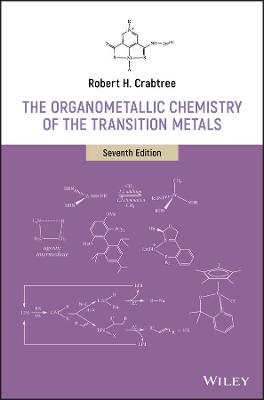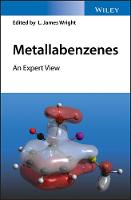Organometallic Chemistry of the Transition Metals
 -15%
portes grátis
-15%
portes grátis
Organometallic Chemistry of the Transition Metals
Crabtree, Robert H.
John Wiley & Sons Inc
09/2019
464
Dura
Inglês
9781119465881
15 a 20 dias
1028
Descrição não disponível.
Preface xi
Acknowledgments xiii
List of Abbreviations xv
1 Introduction 1
1.1 Why Study Organometallic Chemistry? 1
1.2 Coordination Chemistry 3
1.3 Werner Complexes 3
1.4 The Trans Effect 7
1.5 Soft Versus Hard Ligands 9
1.6 The Crystal Field 10
1.7 The Ligand Field 17
1.8 Two-Electron Three-Center Bonding 19
1.9 Four-Electron Three-Center Bonding 20
1.10 Back Bonding 22
1.11 Trends in d Orbital Energies 26
1.12 Types of Ligand 27
References 32
Problems 33
2 Making Sense of Organometallics 35
2.1 The 18-Electron Rule 35
2.2 Limitations of the 18-Electron Rule 43
2.3 Electron Counting in Reactions 45
2.4 The Oxidation State Concept and its Limitations 46
2.5 Electroneutrality 52
2.6 Coordination Number and Geometry 53
2.7 Effects of Complexation 56
2.8 Differences between Metals 58
References 62
Problems 63
3 Alkyls and Hydrides 65
3.1 Alkyls and Aryls 65
3.2 Other ?-Bonded Ligands 79
3.3 Metal Hydrides 80
3.4 Sigma Complexes 83
3.5 Bond Strengths 86
References 88
Problems 89
4 Ligand Substitution 91
4.1 Metal Carbonyls 91
4.2 Phosphines 100
4.3 N-Heterocyclic Carbenes 103
4.4 Dissociative Substitution 105
4.5 Associative Substitution 109
4.6 Redox Effects and Interchange Substitution 111
4.7 Photochemical Substitution 113
4.8 Counterions and Solvents in Substitution 115
References 116
Problems 118
5 Pi Complexes 121
5.1 Alkene and Alkyne Complexes 121
5.2 Allyl Complexes 126
5.3 Diene Complexes 130
5.4 Cyclopentadienyl Complexes 133
5.5 Arenes and Other Alicyclic Ligands 140
5.6 Metalacycles 143
5.7 Stability of Polyene and Polyenyl Complexes 144
References 145
Problems 145
6 Oxidative Addition and Reductive Elimination 147
6.1 Introduction 147
6.2 Concerted Additions 149
6.3 SN2 Pathways 152
6.4 Radical Mechanisms 153
6.5 Ionic Mechanisms 155
6.6 Reductive Elimination 156
6.7 Sigma Bond Metathesis 162
6.8 Ligand-Assisted 1,2-Additions and Eliminations 163
6.9 Oxidative Coupling 164
6.10 Proton-Coupled Electron Transfer 165
References 166
Problems 167
7 Insertion and Elimination 169
7.1 Introduction 169
7.2 1,1-Insertion 171
7.3 1,2-Insertion 175
7.4 Outer Sphere Insertions 179
7.5 ?-,?-,?- and ?-Elimination 180
References 182
Problems 182
8 Addition and Abstraction 185
8.1 Introduction 185
8.2 Nucleophilic Addition to CO 187
8.3 Nucleophilic Addition to Polyenes and Polyenyls 189
8.4 Nucleophilic Abstraction 196
8.5 Electrophilic Addition and Abstraction 197
8.6 Single-Electron Transfer and Radical Reactions 200
References 201
Problems 202
9 Homogeneous Catalysis 205
9.1 Catalytic Cycles 205
9.2 Alkene Isomerization 211
9.3 Hydrogenation 213
9.4 Alkene Hydroformylation 221
9.5 Alkene Hydrocyanation 223
9.6 Alkene Hydrosilylation 224
9.7 Coupling Reactions 225
9.8 Organometallic Oxidation Catalysis 227
9.9 Electrocatalysis 229
9.10 Photoredox Catalysis 229
9.11 Surface Supported Single-Atom and Cooperative Catalysis 231
References 233
Problems 235
10 Physical Methods 239
10.1 Mechanism 239
10.2 1H NMR Spectroscopy 240
10.3 13C NMR Spectroscopy 243
10.4 31P NMR Spectroscopy 244
10.5 Dynamic NMR 246
10.6 Spin Saturation Transfer 249
10.7 T1 and the Nuclear Overhauser Effect 250
10.8 IR Spectroscopy 254
10.9 Crystallography 256
10.10 Electrochemistry and EPR 257
10.11 Computation 259
10.12 Other Methods 260
References 262
Problems 263
11 M-L Multiple Bonds 265
11.1 Carbenes 265
11.2 Schrock Carbenes 272
11.3 Carbynes 276
11.4 Bridging Carbenes and Carbynes 278
11.5 N-Heterocyclic Carbenes 279
11.6 Multiple Bonds to Heteroatoms 282
References 285
Problems 286
12 Metathesis Polymerization and Bond Activation 289
12.1 Alkene Metathesis 289
12.2 Alkene Dimerization, Oligomerization, and Polymerization 295
12.3 Activation of CO and CO2 301
12.4 C?H Activation 305
12.5 Dehydrogenative Oxidation and Hydrogen Borrowing 309
References 311
Problems 313
13 Green Energy and Materials Applications 317
13.1 Green Chemistry 317
13.2 Energy Chemistry 320
13.3 Clusters and Nanoparticles 323
13.4 Organometallic Materials 325
References 332
Problems 334
14 Organic Applications 337
14.1 Carbon-Carbon and Carbon-Heteroatom Coupling 338
14.2 Metathesis 343
14.3 Cyclopropanation and C-H Insertion 345
14.4 Hydrogenation 346
14.5 Carbonylation 348
14.6 Oxidation 350
14.7 C-H Activation 352
14.8 Click Chemistry and Cycloaddition 355
14.9 Photoredox Catalysis 356
References 359
Problems 360
15 Paramagnetic and High-Oxidation-State Complexes 363
15.1 Magnetism and Spin States 364
15.2 Cyclopentadienyl Complexes 371
15.3 f-Block Complexes 373
References 380
Problems 381
16 Bioorganometallic Chemistry 383
16.1 Introduction 384
16.2 Coenzyme B12 388
16.3 Nitrogen Fixation 394
16.4 Nickel Enzymes 402
16.5 Artificial Enzymes 407
16.6 Biomedical and Biocatalytic Applications 407
References 410
Problems 412
Appendix A: Useful Texts on Allied Topics 415
Appendix B: Major Reaction Types 419
Solutions to Problems 421
Index 437
Acknowledgments xiii
List of Abbreviations xv
1 Introduction 1
1.1 Why Study Organometallic Chemistry? 1
1.2 Coordination Chemistry 3
1.3 Werner Complexes 3
1.4 The Trans Effect 7
1.5 Soft Versus Hard Ligands 9
1.6 The Crystal Field 10
1.7 The Ligand Field 17
1.8 Two-Electron Three-Center Bonding 19
1.9 Four-Electron Three-Center Bonding 20
1.10 Back Bonding 22
1.11 Trends in d Orbital Energies 26
1.12 Types of Ligand 27
References 32
Problems 33
2 Making Sense of Organometallics 35
2.1 The 18-Electron Rule 35
2.2 Limitations of the 18-Electron Rule 43
2.3 Electron Counting in Reactions 45
2.4 The Oxidation State Concept and its Limitations 46
2.5 Electroneutrality 52
2.6 Coordination Number and Geometry 53
2.7 Effects of Complexation 56
2.8 Differences between Metals 58
References 62
Problems 63
3 Alkyls and Hydrides 65
3.1 Alkyls and Aryls 65
3.2 Other ?-Bonded Ligands 79
3.3 Metal Hydrides 80
3.4 Sigma Complexes 83
3.5 Bond Strengths 86
References 88
Problems 89
4 Ligand Substitution 91
4.1 Metal Carbonyls 91
4.2 Phosphines 100
4.3 N-Heterocyclic Carbenes 103
4.4 Dissociative Substitution 105
4.5 Associative Substitution 109
4.6 Redox Effects and Interchange Substitution 111
4.7 Photochemical Substitution 113
4.8 Counterions and Solvents in Substitution 115
References 116
Problems 118
5 Pi Complexes 121
5.1 Alkene and Alkyne Complexes 121
5.2 Allyl Complexes 126
5.3 Diene Complexes 130
5.4 Cyclopentadienyl Complexes 133
5.5 Arenes and Other Alicyclic Ligands 140
5.6 Metalacycles 143
5.7 Stability of Polyene and Polyenyl Complexes 144
References 145
Problems 145
6 Oxidative Addition and Reductive Elimination 147
6.1 Introduction 147
6.2 Concerted Additions 149
6.3 SN2 Pathways 152
6.4 Radical Mechanisms 153
6.5 Ionic Mechanisms 155
6.6 Reductive Elimination 156
6.7 Sigma Bond Metathesis 162
6.8 Ligand-Assisted 1,2-Additions and Eliminations 163
6.9 Oxidative Coupling 164
6.10 Proton-Coupled Electron Transfer 165
References 166
Problems 167
7 Insertion and Elimination 169
7.1 Introduction 169
7.2 1,1-Insertion 171
7.3 1,2-Insertion 175
7.4 Outer Sphere Insertions 179
7.5 ?-,?-,?- and ?-Elimination 180
References 182
Problems 182
8 Addition and Abstraction 185
8.1 Introduction 185
8.2 Nucleophilic Addition to CO 187
8.3 Nucleophilic Addition to Polyenes and Polyenyls 189
8.4 Nucleophilic Abstraction 196
8.5 Electrophilic Addition and Abstraction 197
8.6 Single-Electron Transfer and Radical Reactions 200
References 201
Problems 202
9 Homogeneous Catalysis 205
9.1 Catalytic Cycles 205
9.2 Alkene Isomerization 211
9.3 Hydrogenation 213
9.4 Alkene Hydroformylation 221
9.5 Alkene Hydrocyanation 223
9.6 Alkene Hydrosilylation 224
9.7 Coupling Reactions 225
9.8 Organometallic Oxidation Catalysis 227
9.9 Electrocatalysis 229
9.10 Photoredox Catalysis 229
9.11 Surface Supported Single-Atom and Cooperative Catalysis 231
References 233
Problems 235
10 Physical Methods 239
10.1 Mechanism 239
10.2 1H NMR Spectroscopy 240
10.3 13C NMR Spectroscopy 243
10.4 31P NMR Spectroscopy 244
10.5 Dynamic NMR 246
10.6 Spin Saturation Transfer 249
10.7 T1 and the Nuclear Overhauser Effect 250
10.8 IR Spectroscopy 254
10.9 Crystallography 256
10.10 Electrochemistry and EPR 257
10.11 Computation 259
10.12 Other Methods 260
References 262
Problems 263
11 M-L Multiple Bonds 265
11.1 Carbenes 265
11.2 Schrock Carbenes 272
11.3 Carbynes 276
11.4 Bridging Carbenes and Carbynes 278
11.5 N-Heterocyclic Carbenes 279
11.6 Multiple Bonds to Heteroatoms 282
References 285
Problems 286
12 Metathesis Polymerization and Bond Activation 289
12.1 Alkene Metathesis 289
12.2 Alkene Dimerization, Oligomerization, and Polymerization 295
12.3 Activation of CO and CO2 301
12.4 C?H Activation 305
12.5 Dehydrogenative Oxidation and Hydrogen Borrowing 309
References 311
Problems 313
13 Green Energy and Materials Applications 317
13.1 Green Chemistry 317
13.2 Energy Chemistry 320
13.3 Clusters and Nanoparticles 323
13.4 Organometallic Materials 325
References 332
Problems 334
14 Organic Applications 337
14.1 Carbon-Carbon and Carbon-Heteroatom Coupling 338
14.2 Metathesis 343
14.3 Cyclopropanation and C-H Insertion 345
14.4 Hydrogenation 346
14.5 Carbonylation 348
14.6 Oxidation 350
14.7 C-H Activation 352
14.8 Click Chemistry and Cycloaddition 355
14.9 Photoredox Catalysis 356
References 359
Problems 360
15 Paramagnetic and High-Oxidation-State Complexes 363
15.1 Magnetism and Spin States 364
15.2 Cyclopentadienyl Complexes 371
15.3 f-Block Complexes 373
References 380
Problems 381
16 Bioorganometallic Chemistry 383
16.1 Introduction 384
16.2 Coenzyme B12 388
16.3 Nitrogen Fixation 394
16.4 Nickel Enzymes 402
16.5 Artificial Enzymes 407
16.6 Biomedical and Biocatalytic Applications 407
References 410
Problems 412
Appendix A: Useful Texts on Allied Topics 415
Appendix B: Major Reaction Types 419
Solutions to Problems 421
Index 437
Este título pertence ao(s) assunto(s) indicados(s). Para ver outros títulos clique no assunto desejado.
<p>organometallic chemistry; organometallic; transition metals; organometallics; chemistry; inorganic metal ions; organic molecules; product synthesis; polymers; materials science; polymer science; pharmaceuticals; synthetic organic chemistry; biotech</p>
Preface xi
Acknowledgments xiii
List of Abbreviations xv
1 Introduction 1
1.1 Why Study Organometallic Chemistry? 1
1.2 Coordination Chemistry 3
1.3 Werner Complexes 3
1.4 The Trans Effect 7
1.5 Soft Versus Hard Ligands 9
1.6 The Crystal Field 10
1.7 The Ligand Field 17
1.8 Two-Electron Three-Center Bonding 19
1.9 Four-Electron Three-Center Bonding 20
1.10 Back Bonding 22
1.11 Trends in d Orbital Energies 26
1.12 Types of Ligand 27
References 32
Problems 33
2 Making Sense of Organometallics 35
2.1 The 18-Electron Rule 35
2.2 Limitations of the 18-Electron Rule 43
2.3 Electron Counting in Reactions 45
2.4 The Oxidation State Concept and its Limitations 46
2.5 Electroneutrality 52
2.6 Coordination Number and Geometry 53
2.7 Effects of Complexation 56
2.8 Differences between Metals 58
References 62
Problems 63
3 Alkyls and Hydrides 65
3.1 Alkyls and Aryls 65
3.2 Other ?-Bonded Ligands 79
3.3 Metal Hydrides 80
3.4 Sigma Complexes 83
3.5 Bond Strengths 86
References 88
Problems 89
4 Ligand Substitution 91
4.1 Metal Carbonyls 91
4.2 Phosphines 100
4.3 N-Heterocyclic Carbenes 103
4.4 Dissociative Substitution 105
4.5 Associative Substitution 109
4.6 Redox Effects and Interchange Substitution 111
4.7 Photochemical Substitution 113
4.8 Counterions and Solvents in Substitution 115
References 116
Problems 118
5 Pi Complexes 121
5.1 Alkene and Alkyne Complexes 121
5.2 Allyl Complexes 126
5.3 Diene Complexes 130
5.4 Cyclopentadienyl Complexes 133
5.5 Arenes and Other Alicyclic Ligands 140
5.6 Metalacycles 143
5.7 Stability of Polyene and Polyenyl Complexes 144
References 145
Problems 145
6 Oxidative Addition and Reductive Elimination 147
6.1 Introduction 147
6.2 Concerted Additions 149
6.3 SN2 Pathways 152
6.4 Radical Mechanisms 153
6.5 Ionic Mechanisms 155
6.6 Reductive Elimination 156
6.7 Sigma Bond Metathesis 162
6.8 Ligand-Assisted 1,2-Additions and Eliminations 163
6.9 Oxidative Coupling 164
6.10 Proton-Coupled Electron Transfer 165
References 166
Problems 167
7 Insertion and Elimination 169
7.1 Introduction 169
7.2 1,1-Insertion 171
7.3 1,2-Insertion 175
7.4 Outer Sphere Insertions 179
7.5 ?-,?-,?- and ?-Elimination 180
References 182
Problems 182
8 Addition and Abstraction 185
8.1 Introduction 185
8.2 Nucleophilic Addition to CO 187
8.3 Nucleophilic Addition to Polyenes and Polyenyls 189
8.4 Nucleophilic Abstraction 196
8.5 Electrophilic Addition and Abstraction 197
8.6 Single-Electron Transfer and Radical Reactions 200
References 201
Problems 202
9 Homogeneous Catalysis 205
9.1 Catalytic Cycles 205
9.2 Alkene Isomerization 211
9.3 Hydrogenation 213
9.4 Alkene Hydroformylation 221
9.5 Alkene Hydrocyanation 223
9.6 Alkene Hydrosilylation 224
9.7 Coupling Reactions 225
9.8 Organometallic Oxidation Catalysis 227
9.9 Electrocatalysis 229
9.10 Photoredox Catalysis 229
9.11 Surface Supported Single-Atom and Cooperative Catalysis 231
References 233
Problems 235
10 Physical Methods 239
10.1 Mechanism 239
10.2 1H NMR Spectroscopy 240
10.3 13C NMR Spectroscopy 243
10.4 31P NMR Spectroscopy 244
10.5 Dynamic NMR 246
10.6 Spin Saturation Transfer 249
10.7 T1 and the Nuclear Overhauser Effect 250
10.8 IR Spectroscopy 254
10.9 Crystallography 256
10.10 Electrochemistry and EPR 257
10.11 Computation 259
10.12 Other Methods 260
References 262
Problems 263
11 M-L Multiple Bonds 265
11.1 Carbenes 265
11.2 Schrock Carbenes 272
11.3 Carbynes 276
11.4 Bridging Carbenes and Carbynes 278
11.5 N-Heterocyclic Carbenes 279
11.6 Multiple Bonds to Heteroatoms 282
References 285
Problems 286
12 Metathesis Polymerization and Bond Activation 289
12.1 Alkene Metathesis 289
12.2 Alkene Dimerization, Oligomerization, and Polymerization 295
12.3 Activation of CO and CO2 301
12.4 C?H Activation 305
12.5 Dehydrogenative Oxidation and Hydrogen Borrowing 309
References 311
Problems 313
13 Green Energy and Materials Applications 317
13.1 Green Chemistry 317
13.2 Energy Chemistry 320
13.3 Clusters and Nanoparticles 323
13.4 Organometallic Materials 325
References 332
Problems 334
14 Organic Applications 337
14.1 Carbon-Carbon and Carbon-Heteroatom Coupling 338
14.2 Metathesis 343
14.3 Cyclopropanation and C-H Insertion 345
14.4 Hydrogenation 346
14.5 Carbonylation 348
14.6 Oxidation 350
14.7 C-H Activation 352
14.8 Click Chemistry and Cycloaddition 355
14.9 Photoredox Catalysis 356
References 359
Problems 360
15 Paramagnetic and High-Oxidation-State Complexes 363
15.1 Magnetism and Spin States 364
15.2 Cyclopentadienyl Complexes 371
15.3 f-Block Complexes 373
References 380
Problems 381
16 Bioorganometallic Chemistry 383
16.1 Introduction 384
16.2 Coenzyme B12 388
16.3 Nitrogen Fixation 394
16.4 Nickel Enzymes 402
16.5 Artificial Enzymes 407
16.6 Biomedical and Biocatalytic Applications 407
References 410
Problems 412
Appendix A: Useful Texts on Allied Topics 415
Appendix B: Major Reaction Types 419
Solutions to Problems 421
Index 437
Acknowledgments xiii
List of Abbreviations xv
1 Introduction 1
1.1 Why Study Organometallic Chemistry? 1
1.2 Coordination Chemistry 3
1.3 Werner Complexes 3
1.4 The Trans Effect 7
1.5 Soft Versus Hard Ligands 9
1.6 The Crystal Field 10
1.7 The Ligand Field 17
1.8 Two-Electron Three-Center Bonding 19
1.9 Four-Electron Three-Center Bonding 20
1.10 Back Bonding 22
1.11 Trends in d Orbital Energies 26
1.12 Types of Ligand 27
References 32
Problems 33
2 Making Sense of Organometallics 35
2.1 The 18-Electron Rule 35
2.2 Limitations of the 18-Electron Rule 43
2.3 Electron Counting in Reactions 45
2.4 The Oxidation State Concept and its Limitations 46
2.5 Electroneutrality 52
2.6 Coordination Number and Geometry 53
2.7 Effects of Complexation 56
2.8 Differences between Metals 58
References 62
Problems 63
3 Alkyls and Hydrides 65
3.1 Alkyls and Aryls 65
3.2 Other ?-Bonded Ligands 79
3.3 Metal Hydrides 80
3.4 Sigma Complexes 83
3.5 Bond Strengths 86
References 88
Problems 89
4 Ligand Substitution 91
4.1 Metal Carbonyls 91
4.2 Phosphines 100
4.3 N-Heterocyclic Carbenes 103
4.4 Dissociative Substitution 105
4.5 Associative Substitution 109
4.6 Redox Effects and Interchange Substitution 111
4.7 Photochemical Substitution 113
4.8 Counterions and Solvents in Substitution 115
References 116
Problems 118
5 Pi Complexes 121
5.1 Alkene and Alkyne Complexes 121
5.2 Allyl Complexes 126
5.3 Diene Complexes 130
5.4 Cyclopentadienyl Complexes 133
5.5 Arenes and Other Alicyclic Ligands 140
5.6 Metalacycles 143
5.7 Stability of Polyene and Polyenyl Complexes 144
References 145
Problems 145
6 Oxidative Addition and Reductive Elimination 147
6.1 Introduction 147
6.2 Concerted Additions 149
6.3 SN2 Pathways 152
6.4 Radical Mechanisms 153
6.5 Ionic Mechanisms 155
6.6 Reductive Elimination 156
6.7 Sigma Bond Metathesis 162
6.8 Ligand-Assisted 1,2-Additions and Eliminations 163
6.9 Oxidative Coupling 164
6.10 Proton-Coupled Electron Transfer 165
References 166
Problems 167
7 Insertion and Elimination 169
7.1 Introduction 169
7.2 1,1-Insertion 171
7.3 1,2-Insertion 175
7.4 Outer Sphere Insertions 179
7.5 ?-,?-,?- and ?-Elimination 180
References 182
Problems 182
8 Addition and Abstraction 185
8.1 Introduction 185
8.2 Nucleophilic Addition to CO 187
8.3 Nucleophilic Addition to Polyenes and Polyenyls 189
8.4 Nucleophilic Abstraction 196
8.5 Electrophilic Addition and Abstraction 197
8.6 Single-Electron Transfer and Radical Reactions 200
References 201
Problems 202
9 Homogeneous Catalysis 205
9.1 Catalytic Cycles 205
9.2 Alkene Isomerization 211
9.3 Hydrogenation 213
9.4 Alkene Hydroformylation 221
9.5 Alkene Hydrocyanation 223
9.6 Alkene Hydrosilylation 224
9.7 Coupling Reactions 225
9.8 Organometallic Oxidation Catalysis 227
9.9 Electrocatalysis 229
9.10 Photoredox Catalysis 229
9.11 Surface Supported Single-Atom and Cooperative Catalysis 231
References 233
Problems 235
10 Physical Methods 239
10.1 Mechanism 239
10.2 1H NMR Spectroscopy 240
10.3 13C NMR Spectroscopy 243
10.4 31P NMR Spectroscopy 244
10.5 Dynamic NMR 246
10.6 Spin Saturation Transfer 249
10.7 T1 and the Nuclear Overhauser Effect 250
10.8 IR Spectroscopy 254
10.9 Crystallography 256
10.10 Electrochemistry and EPR 257
10.11 Computation 259
10.12 Other Methods 260
References 262
Problems 263
11 M-L Multiple Bonds 265
11.1 Carbenes 265
11.2 Schrock Carbenes 272
11.3 Carbynes 276
11.4 Bridging Carbenes and Carbynes 278
11.5 N-Heterocyclic Carbenes 279
11.6 Multiple Bonds to Heteroatoms 282
References 285
Problems 286
12 Metathesis Polymerization and Bond Activation 289
12.1 Alkene Metathesis 289
12.2 Alkene Dimerization, Oligomerization, and Polymerization 295
12.3 Activation of CO and CO2 301
12.4 C?H Activation 305
12.5 Dehydrogenative Oxidation and Hydrogen Borrowing 309
References 311
Problems 313
13 Green Energy and Materials Applications 317
13.1 Green Chemistry 317
13.2 Energy Chemistry 320
13.3 Clusters and Nanoparticles 323
13.4 Organometallic Materials 325
References 332
Problems 334
14 Organic Applications 337
14.1 Carbon-Carbon and Carbon-Heteroatom Coupling 338
14.2 Metathesis 343
14.3 Cyclopropanation and C-H Insertion 345
14.4 Hydrogenation 346
14.5 Carbonylation 348
14.6 Oxidation 350
14.7 C-H Activation 352
14.8 Click Chemistry and Cycloaddition 355
14.9 Photoredox Catalysis 356
References 359
Problems 360
15 Paramagnetic and High-Oxidation-State Complexes 363
15.1 Magnetism and Spin States 364
15.2 Cyclopentadienyl Complexes 371
15.3 f-Block Complexes 373
References 380
Problems 381
16 Bioorganometallic Chemistry 383
16.1 Introduction 384
16.2 Coenzyme B12 388
16.3 Nitrogen Fixation 394
16.4 Nickel Enzymes 402
16.5 Artificial Enzymes 407
16.6 Biomedical and Biocatalytic Applications 407
References 410
Problems 412
Appendix A: Useful Texts on Allied Topics 415
Appendix B: Major Reaction Types 419
Solutions to Problems 421
Index 437
Este título pertence ao(s) assunto(s) indicados(s). Para ver outros títulos clique no assunto desejado.




